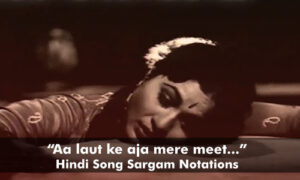
Category: Rabindra Sangeet


Boro asha kore esechhi
June 3, 2015
10 Comments

Eki labonye purno prano
April 2, 2017
2 Comments

Ektuku chhoa lage
March 13, 2017
1 Comment

Gram Chhara Oyi Ranga Matir Poth
July 25, 2018
No Comments

He gombhir (Neel anjano ghono)
January 13, 2022
No Comments

Hridoy amar nache re ajke
December 17, 2016
No Comments

Jodi tor dak shune (Ekla Cholo Re)
April 23, 2015
8 Comments

Mor bhabona re ki haway
April 20, 2017
No Comments

O Amar Desher Maati
March 12, 2023
No Comments

Purano shei diner kotha
May 15, 2016
8 Comments

Tomar khola haowa
April 29, 2021
No Comments

Tumi Robe Nirobe
June 20, 2020
3 Comments
All Categories
How to read SARGAM
- CAPITAL LETTERS = Shuddh Swars (Natural Notes)
- small letters = Komal Swars (Flat Notes)
- M with # [hash] or ^ [exponent] = Tivra Madhyam (M# / M^)
- Letter/Alphabet ONLY = Medium Pitch/Normal blow on flute
- Letter/Alphabet PRECEDED BY a ” . ” [full stop] or a ” , ” [comma] = Low Octave Note/Softer blow on flute
- Letter/Alphabet FOLLOWED BY a ‘ [single quote] = High Octave Note/harder blow on flute
- Notes in { } = “murki” have to be played very fast without any pause
- A Note in ( ) = “kann swar” has to be just touched before moving on to the next note
- A “~” between two Notes = “meend”. That is, you have to glide from one note to another slowly to produce that wavy effect.
- Few “….” (dots) after a note = Play and hold that note
Latest Update


